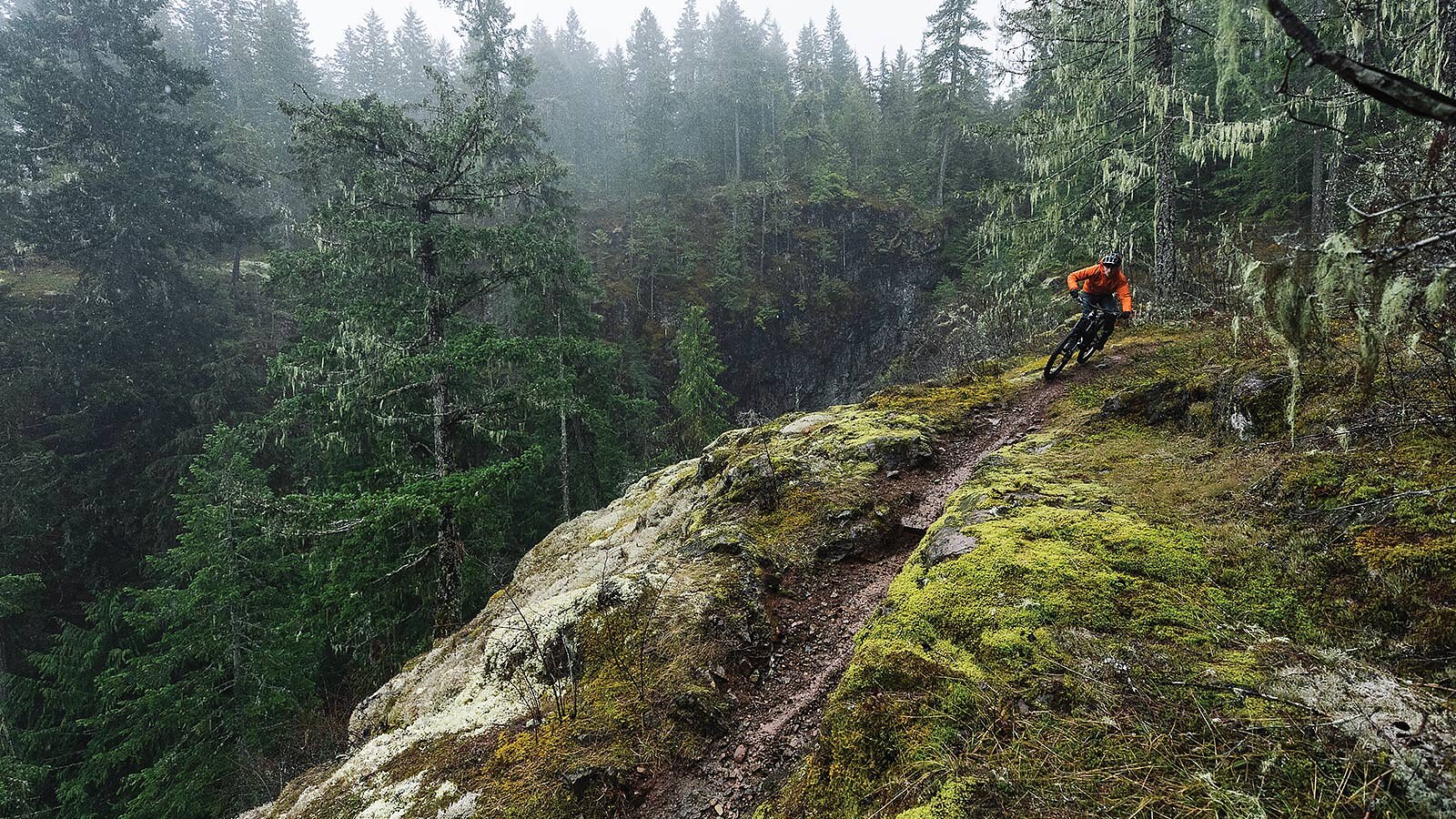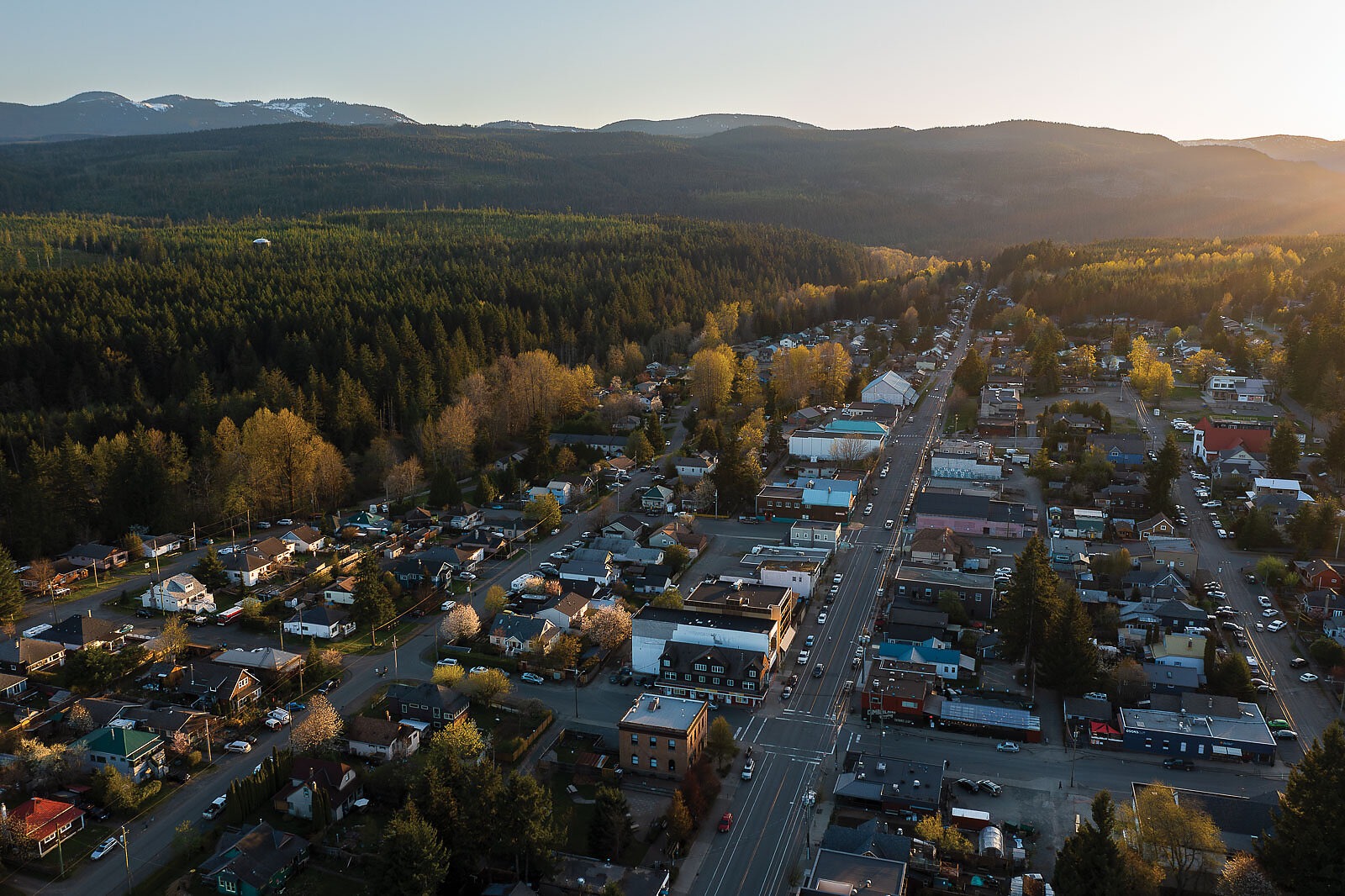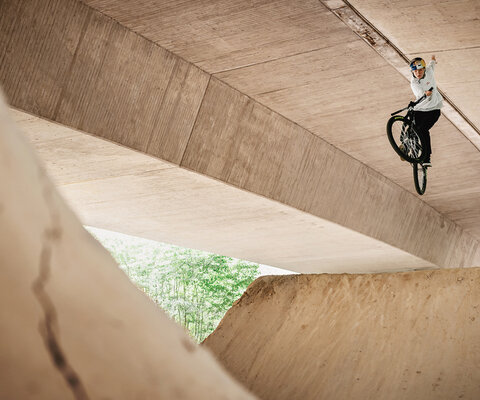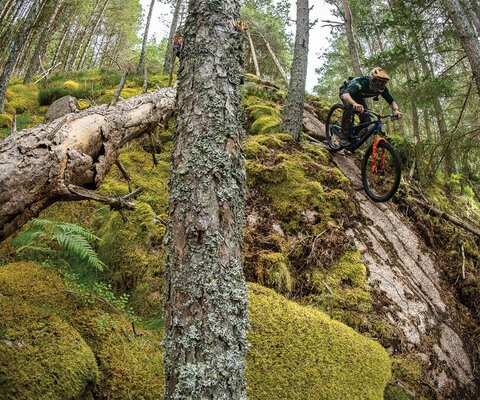
Organized Anarchy The Grassroots Trail Revival of a Once-Gritty Mining Town
Words by Andrew Findlay | Photos by Haruki "Harookz" Noguchi
Jeremy Grasby gets a little nostalgic whenever he rides past the yellow gate and enters the labyrinth of singletrack that is the Cumberland network. It’s short-sleeves weather. Trillium flowers are blossoming in the forests of Vancouver Island while the western toads croak their horny approval of spring’s arrival. There’s even a puff of dust in the air as Grasby rails a tight right-hander on Bear Buns, a local classic.
The trailhead parking lot was already halffull on a mid-week morning when he spun past half an hour earlier. It’s a testament to the fact that Cumberland singletrack—120 miles of it and counting, virtually all built on private forest land—is among the most used networks in North America according to online trail mapping resources.
What a journey it’s been.
Cumberland is one of three communities— Courtenay and Comox are the others—that comprise the Comox Valley, even though it’s not really a valley. Some might say it’s the coolest of the three, but it hasn’t always been that way.
“There are so many memories in these hills—a bridge here that I built with my girls, a berm there, a rock that we moved,” Grasby said, who has lived in Cumberland since 2002.
A solo female on an e-bike is paused at Syke’s Bridge, studying her smartphone intensely.
“You all good? You know where you’re going?” Grasby asks, the consummate trail ambassador.
“I think so,” she replies.
His embassy services only go so far. Especially on the first warm day of the season when an electric springtime buzz fills the air. The dirt is tacky and the snowline has receded almost to the top of the network. He doesn’t stop to inquire further. She’ll figure it out.


Grasby has a confident, direct way of speaking underpinned by a strong sense of place, and even history. Saying he is proud of Cumberland’s trails is akin to saying Canadians like maple syrup. Civic pride built this trail network, and pride is written into the DNA of Cumberland, whose population hovers around 4,000 and sits halfway up the east side of Vancouver Island, tucked into a shallow fold in the land where the Beaufort Range meets Comox Lake.
In the late 1800s, prospectors discovered coal in these wild rolling hills five miles from the sea. Early attempts to mine these claims failed. Then, along came Scottish wheeler and dealer Robert Dunsmuir.
At the time, Canada was a new country and incomplete. Though the province of British Columbia had been recently formed, Vancouver Island remained a British Colony. The Canadian government desperately wanted to bring this rainforest-shrouded, 300-mile-long rock on the west coast into the national fold. So, they came up with a scheme to give $100,000 annually for the building of a railway on Vancouver Island to “connect the seaboard of BC with the railway system of Canada,” as one government official put when the deal was being cobbled together. In turn, the B.C. government kicked in $750,000 and promised to hand over 3,200 square miles of Vancouver Island—including its natural resources—to the company that constructed the railway. In 1884, the shrewd Dunsmuir stepped up to claim this prize, which included the land on which the town of Cumberland would eventually be founded. This massive land giveaway was unprecedented in Canada and would shape land use, development, and access on the east coast of Vancouver Island in profound ways that still exist today.
Dunsmuir cared little about trains. He wanted what was below the ground: coal. His coal mines made the Dunsmuir family filthy rich and Cumberland grew into a bustling, multicultural mining community populated by immigrants from across Europe and Asia. Workers of color earned less than half the wage of whites and the treacherous mines took a terrible toll. Over the course of seven decades, more than 300 workers perished in mining accidents and related illnesses.
The hardship of life working underground forged a community-minded spirit and solidarity that persisted until the last coal mine shut in the 1950s. Cumberland, as a town, fell into a deep, decades-long slumber. Wooden buildings fell into disrepair. The main street, Dunsmuir Avenue, was soon pocked with crater-sized potholes. Dunsmuir’s private land empire had already been parceled up and sold to a number of different timber companies. Non-residents sneered at the village, labeling it “Scumberland.” But for every person mocking it as a place full of drunks and addicts, there was someone else snagging a house for less than $80,000 and fixing it up.

In the late 1990s, Grasby was working for the B.C. Forest Service in Campbell River, 30 miles up-island. He started driving to Cumberland to compete in local cross-country races on trails that have long since been consumed by a modern, decidedly generic-looking housing development on the village’s outskirts. Back then there was a small but well-established trailbuilding and riding scene. It was full rogue—scratching in trails on private forest land. The ethos of that era was build first, ask for permission later.
“It was grassroots,” Grasby said. “I felt right at home.”
Life took him elsewhere, momentarily. He landed another forestry job and moved to Merritt, a ranching and logging town south of Kamloops, something he later recalled as “the worst decision of my life.”
By then Vancouver Island had sunk its incisors into his soul. He sketched out a plan on a napkin to open a mountain biking-friendly hostel in Cumberland. He quit the government, took a small severance payout, cashed in his meager retirement benefits, and moved back.
The Riding Fool Hostel opened in 2003 in a 120-year-old former hardware store that was a windows-smashed-out shell of a building before Grasby and a small army of friends and volunteers undertook a seven-month renovation.
To celebrate the opening, Grasby phoned the village office to ask if they could dump a few truckloads of dirt on Dunsmuir Avenue and build jumps. They agreed.
He soon added his energy to local trailbuilding, which had been fostered by the likes of Dan Espeseth (now the longtime owner of Dodge City Cycles), James Powsey (before he became a tugboat captain), Jeff “Jefe” Guerney, and too many others to mention. Good old boys just doing what they loved to do—building trails and riding bikes. They would camp out overnight on the hills above town to work on early edition gravity trails such as Grub and Stub. Closer to town, there was wiggly singletrack like Black Hole, named after an old, collapsed coal shaft hidden in the bush next to the trail.


Grasby and some of his trailbuilding buddies took to calling themselves “THC,” or the Trail Harvesting Club. And harvest they did. The network grew in a sort of organized anarchy, the way mycelium spreads beneath a forest floor and manifests magically as mushrooms. Cumberland was morphing organically beyond a local trail secret into a 100 percent, volunteer-built destination for riding. TimberWest and Island Timberlands,the two companies that owned most of the land around Cumberland, had tolerated and, at times, even assisted trailbuilding efforts. But it was a tenuous relationship. Besides community goodwill, there wasn’t much upside to allowing recreation on their lands, just risk of forest fire, risk of impeding logging operations, and risk of potential liability if someone broke their neck sending it on Bucket of Blood, a longtime Cumberland favorite.
With its rocky knoll drop-in, Bucket of Blood was an enduro-style trail before the word “enduro” had even entered the mountain biking lexicon. It has rock rolls, janky off-camber roots, drops, and spicy wooden features. And it’s gone through many evolutions and iterations. When it was first built, the trail descended entirely through mature, second-growth forest.
In 2008, when local riders got word that TimberWest was going to log Bucket of Blood, it sparked panic. The logging company had made it clear that nothing could be done to legitimize trails on its land before a land use agreement was in place. About 96 percent of B.C. is public land, or Crown land as they call it in Canada—a hold-over from the days of British colonization. There are procedures, laws, and protocols in place for developing recreational trails on public lands, but with Cumberland surrounded by private land, the situation posed unique challenges.
Concern about losing Bucket of Blood prompted Grasby and Colin Wilson, a chiropractor and fellow mountain biking enthusiast, to organize a meeting with local politicians to make the case for mountain biking’s economic, social, and community benefits. In preparation, Wilson made a digital map with two layers, one showing all the trails and the other showing all the officially sanctioned trails around Cumberland. The former was a spider’s web of wiggly lines, the latter was more or less blank. It was a compelling graphic, but when the duo asked for help in developing a land use agreement, one of the politicians asked; “Who are you, and who do you represent?”

“GROWING UP RIDING IN CUMBERLAND IS A BIG REASON FOR MY SUCCESS. THESE TRAILS HAVE THEIR OWN KIND OF JANK. WHEN I WANT TO TRAIN IN THE OFF-SEASON I DON’T NEED TO GO ANYWHERE ELSE.” —EMMY LAN
“That’s when we knew we had to get our shit together,” Grasby said.
So they did. By that time, they were informally calling themselves UROC (United Riders of Cumberland.) In December of 2008 UROC officially incorporated as a society. Its inaugural five-member board included president Grasby and treasurer Mike Manara, who would play a key role in checking off item #2 on the society’s nine-item constitution—to foster a positive working relationship with landowners to facilitate land access.
One of the first bylaws the UROC-board established to guide meetings stated: “Beer: late guy buys beer unless arriving before 9 p.m.”
It would take a lot of beer, scrutinizing maps, and talking to foresters to achieve the next major milestone. In 2015, UROC signed a land use agreement with the logging companies that covered 6,500 acres of working forest. The pioneering agreement dealt with the liability question and legitimized a trail network that had outgrown its renegade origins. Official trail signage and map kiosks could now be built and UROC could market the trails and confidently apply for grants to pay for trail maintenance and trail crew, something funders wouldn’t have touched when the network was unsanctioned.
Gone were Cumberland’s days of free-for-all trailbuilding, and UROC received pushback from some who had grown accustomed to building wherever and whenever they wanted. The tradeoff, on the other hand, meant local mountain bikers now had a cooperative dialogue with the logging companies to get new trails approved.
On a recent afternoon, a few staples of the trailbuilding community plied their trade. Grasby stopped on Off Broadway to inspect dirt work he and one of his daughters had completed a few days earlier. He wasn’t pleased—the work was poorly timed with an intense rainstorm that turned the fresh dirt into a messy slurry.

Further up the hill, Dougal Browne and his crew scratched out the beginnings of a trail linking the bottom of Racerocks with Potluck, named for when the original builders stumbled across an illicit outdoor cannabis grow.
“When this trail is finished it will make for a continuous black diamond singletrack descent from the top of the network at 720 meters [2,400 feet] to the trailhead,” Browne said, who hired on as UROC’s first full-time executive director in 2019.
It’s a busy role. He looks after UROC’s full-time trail crew trio, as well as 11 other builders contracted on a project-by-project basis. He manages the land use agreement with the logging companies and the sometimes-rocky relationship with the conservation-focused Cumberland Community Forest Society, a nonprofit that has bought and preserved more than 500 acres of forest land next to town. (Some of Cumberland’s oldest and most beloved close-to-town trails such as Space Nugget and Orange Peels lie within the community forest). Browne also fills out funding grant applications and massages relationships between the growing numbers of trail runners, hikers, and dog walkers that share the trails with mountain bikers.
How Browne ended up managing one of the busiest trail networks in North America is somewhat random. His accent is ambiguous, reflective of an international upbringing as the son of a Scottish-born, British military father who bounced around from posting to posting with his family. In 2008, while living in South Africa, Browne met his future Canadian wife in a bar. Eventually, he ended up in Bowser, a small seaside community south of Cumberland where he began his forays into trailwork.
“Trails are like art. Seeing a forest, a piece of land and imagining what it could be,” Browne says with a feverishly passionate look in his eyes.
Like many riders who fall into professional advocacy jobs, he’s still happiest with dirt under his fingernails. But with a degree in construction management and town planning, he’s right at home.

Not long after Browne stepped into his role heading up UROC, COVID-19 dropped like a bomb. The initial shock of the pandemic shutdown was followed by an unexpected explosion in mountain biking interest. From seven-year-olds to 70-year-olds, plumbers to pediatricians, every demographic seemed to be suddenly wanting to ride blue square flow trails.
Before the pandemic, nine trail counters in the Cumberland network recorded 120,000 trail rides. In 2022, there were 220,000. Browne is fond of numbers. The trail counter at the top of the networks’ machine built climbing trail, Sobo No Michi, recorded 97,000 visits in 2022, most of them likely mountain bikers.
“Trailforks captures kilometers traveled for each user and the Cumberland average ride is 17 kilometers,” Browne says before doing the math. “It’s like Cumberland riders are pedaling the equivalent of crossing Canada 368 times in a year. It’s a fairly loose statistic but a fun one nonetheless.”
The pandemic also made clear that Cumberland had long since outgrown its “Scumberland” stigma of the past. In 2021, locals were shocked when a renovated mining shack on Camp Road sold for $1 million. Proximity to trails was proving to be a big draw for newcomers, many of whom were fleeing big cities such as Vancouver on Canada’s mainland.
Beyond the trails, downtown is also shifting. Twenty years ago, people went to the red brick government building to collect their mail. Now they go to buy vinyl from the hipster Moon’s Records. On any given spring afternoon, a hundred thousand dollars in mountain bikes are chained up outside Cumberland Brewing Company where the outdoor patio is jammed with post-ride cheer. It’s the same story at the legendary Waverley Hotel. Cumberland’s mountain biking economy was growing in ways other than beer and pizza. In 2018, British-born Owen Pemberton, then still a design engineer at Norco Bicycles, eyed up Cumberland as the place to launch his start-up brand, Forbidden Bike Company.
“Right from the beginning my goal was to have a bike company that was integrated into a bike culture,” Pemberton said from Forbidden’s office and warehouse, tucked behind Beaufort Cycles. “We can go for lunch-hour company rides. When I was at Norco we didn’t do that because we were an hour’s drive from the trailhead.”


These are busy days for the brand. The company just dropped its Druid II model and is forging a bike demo partnership with Gravity MTB, a mountain bike coaching company that recently opened Gravity Garage, a training center next to a cannabis retailer.
Early in 2023, Forbidden signed homegrown, 19-year-old enduro phenom Emmy Lan, who took top honors in last year’s U-21 Enduro World Series. Though she lives nearby in Comox, Cumberland is like her second home. Lan started riding mountain bikes at age seven on Cumberland dirt. She’s in good company—this network has spawned no shortage of shredders, including Olympian and Canadian national cross-country champ Geoff Kabush, Giant Factory rider Carter Woods, and Emilly Johnston, a cyclocross and cross-country crusher who recently signed with Trek Future Racing.
For Lan, getting her start in Cumberland was a dream.
“Growing up riding in Cumberland is a big reason for my success,” Lan said. “These trails have their own kind of jank. When I want to train in the off-season I don’t need to go anywhere else.”
Forbidden is not alone in seeing the branding and cycling lifestyle potential of Cumberland. This past spring NOBL Wheels relocated to a renovated Dunsmuir Avenue heritage building that once housed a consignment clothing store among many other enterprises in its 100-year history.
When NOBL owner Trevor Howard was considering moving shop from Langley, a suburb of Vancouver, Squamish and Pemberton were on the list at first. But the numbers didn’t make sense. Vancouver Island and Cumberland became the logical choice.
“Trevor always wanted NOBL to be part of a cycling-centered community,” Chris Arruda said, NOBL’s operations manager. “Everybody is stoked to be here.”
Browne, the UROC director, calls it “a bike industry shift” toward Cumberland.
“I’m always blowing smoke up the trailbuilders because they’re the ones who got it all going,” Browne says.
He’s right. The numbers say it all. In 2004, Cumberland had 11 trails. Today there are 200. But sometimes the classics draw you back, the way a song from days past can conjure fond memories—a first date, a tailgater after an unforgettable ride.
After his dirt inspection on Off Broadway, Grasby headed for Short N Curly. In the early days of the Riding Fool Hostel, when Grasby and Manara were homebrewing 30 gallons of beer a year, a visitor jokingly told them to make sure not to get any short-and-curlies in their batch. Thus, a name was born.
On trail, light flickers through the cedar and hemlock as Grasby negotiates roots and rocks that, by now, are seared into his muscle memory. The tap of a woodpecker echoes through the woods. Every trail has a story behind it, just as every mountain biking community has a tale to tell. Cumberland’s just seems to get more and more interesting.





